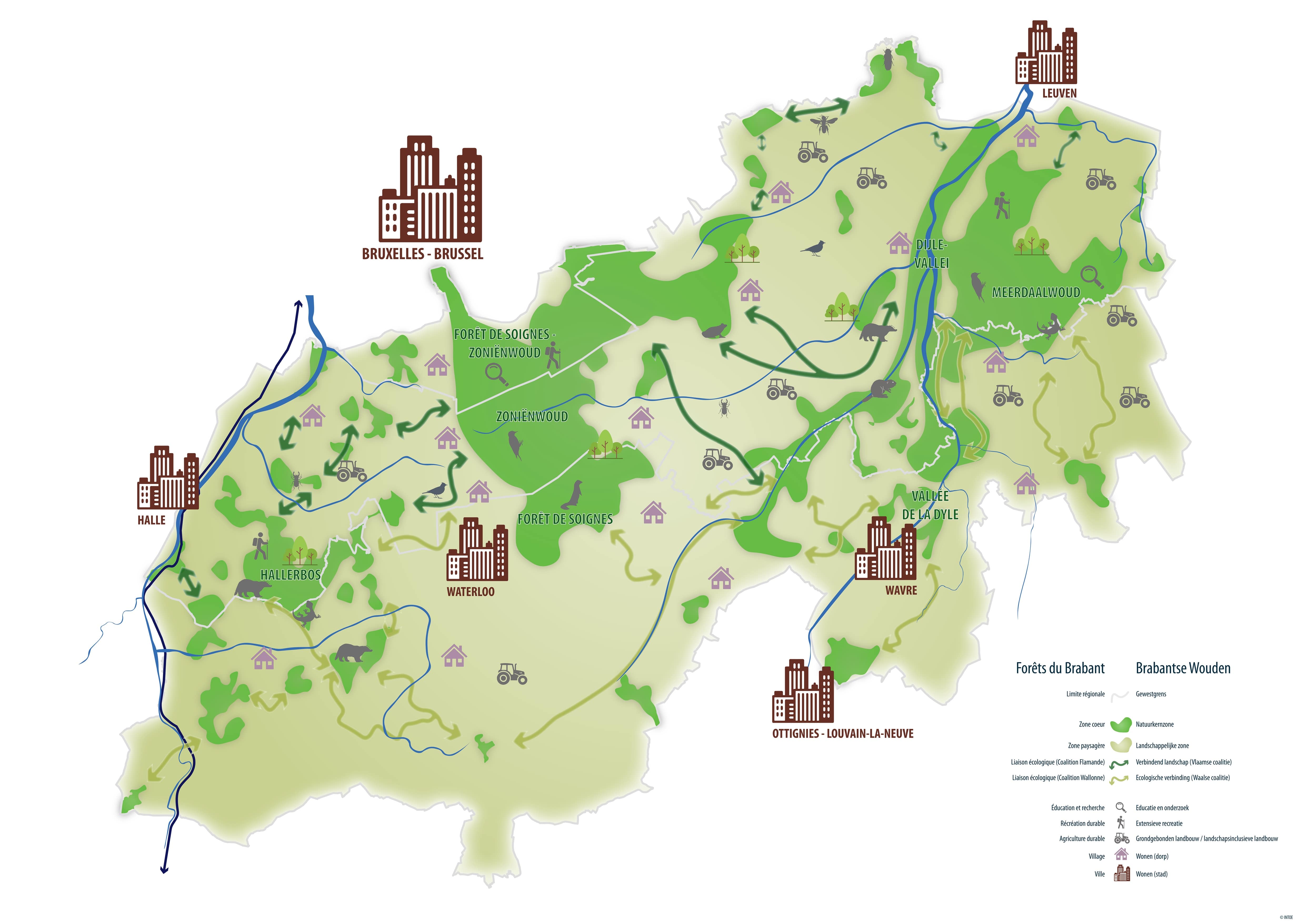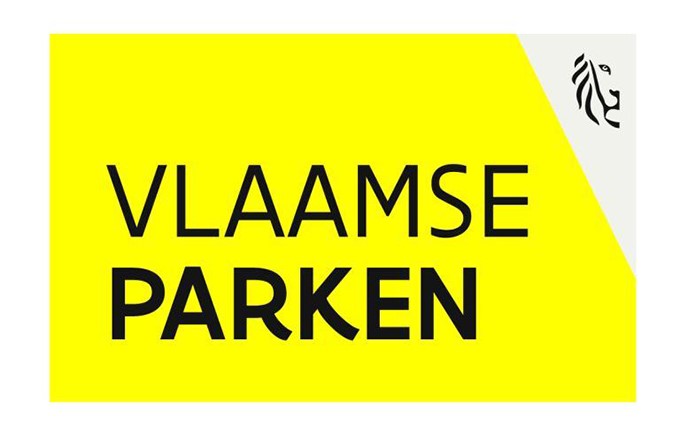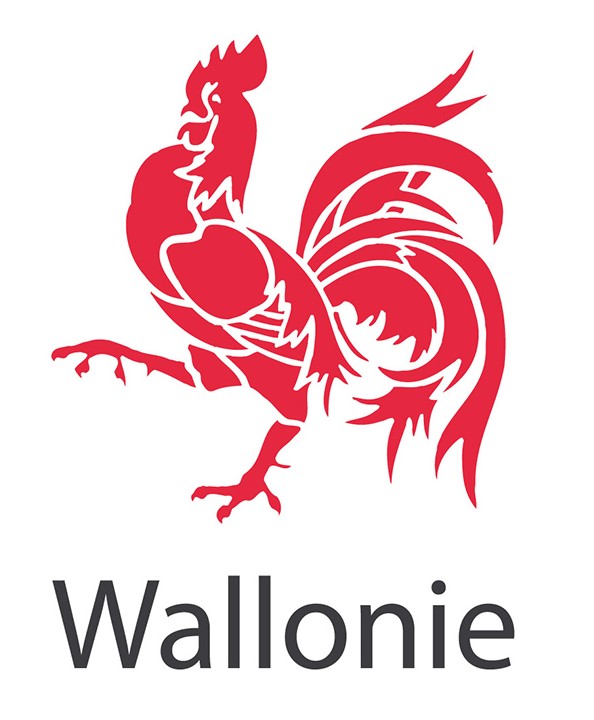Forests of Brabant – Brabantse wouden - Forêts du Brabant
A new National Park is born
Interregional collaboration around nature in the heart of Belgium
Between the historic forests of Soignes, Meerdael and Halle, one is greated by a mosaic of woods, fields and meadows. These forests are connected by authentic villages and winding rivers. Together, these elements form the Forests of Brabant – Brabantse Wouden, a green lung between the cities of Brussels, Leuven, Wavre, Louvain-La-Neuve and Halle.
The Flemish part has been awarded the title of National Park. The three Regions, the two provinces of Brabant and many stakeholders are committed to protecting and enhancing nature in this area interregionally.
A land of ancient forests with a shared history
The Hallerbos, the Sonian Forest and the Meerdael Forest together with the green valleys of the Dyle, Lasne and IJse form the natural backbone of the forests of Brabant.
An extraordinary patchwork of 46,000 hectares of old-growth forests, winding rivers, sunken paths and open landscapes.
In this diverse whole, there is still great potential to strengthen nature. There is also room for recreation and sustainable agriculture.
These forests are very old: the Meerdaal Forest and the Halle Forest are at least a thousand years old, while the Sonian Forest has been a forest since the last ice age.
Together, they form the largest area of old-growth forest in our country.
In the time of Julius Caesar, they formed one and the same 'charcoal forest' (silva carbonaria).
Over the years, this forest has become fragmented, leading to a decline in biodiversity and a decrease in nature's resilience... Thankfully, times have changed!

Unique assets :
- No less than 20,000 monumental trees. Large oaks and beech trees with a circumference of more than three metres.
- A magnificent vernal flora endemic to ancient forests. In spring, the Sylvie Anemone and the Hyacinth of the woods, cover the forest with a beautiful colourful carpet.
- More than 230 kilometres of sunken paths cut deep into the Brabant plateau, while its hillsides serve as a refuge for rare species such as lerots, badgers, the Birch Thecla, the Stag Beetle and the Yellow Bunting.
- The spectacular meanders of the Dyle, Lasne and IJse rivers allow water to be stored by slowing down their flows. An asset for the climate!
- A unique heritage steeped in stories to discover.
- Farmers who grow healthy food, nature and vast landscapes.

Map of the Forests of Brabant

Together for more nature
There is a growing public support for the idea of connecting our forests and natural landscapes rather than urbanizing the last remaining open spaces.
Experiencing nature is now part of a healthier life.
Less tarmac and concrete in our towns and villages, more trees, hedgerows and open waterways are our best bulwarks against drought and flooding.
The recognition of part of the territory as a National Park and the interregional collaboration that this has entailed is a magnificent asset for nature
throughout the Forests of Brabant territory. It’s a necessity because in some places the pressure on nature is very strong.
By strengthening and connecting natural areas and making the agricultural plateau and the centres of our towns and villages greener and more attractive,
we reduce the pressure on the most fragile areas.
Tourism departments are working together to organize sustainable tourism. The experience of nature will be central to this new form of ecotourism.
The reception gates will be installed in the centres of towns and villages and in train stations to further reduce public pressure on the most vulnerable areas.
Ecological connections between core areas will be defined in close consultation with farmers, users and landowners.
This will make nature more resilient to climate change. In this way, forests and grasslands will be able to play a more important role in the storage of water.
The sustainable economy will enable the development of this territory.
Farmers will benefit from short supply chains and wood from our forests will be used as a sustainable building material.
Broad public support and new investors, both public and private, will be addressed to implement these projects that are beneficial for nature.

A coherent vision on the scale of the Brabant Forests
In June 2023, the 3 Regions, the 2 Provinces of Brabant and many stakeholders sealed their collaboration by signing the Interregional Declaration of Intent for the Forests of Brabant. In this text, they agree on a shared ambition to enhance nature in this vast territory of 46,000 hectares with a common history. They are committed to cooperating around forests, habitats, species and rivers. Preserving and redeveloping ecological connections between forests of Halle, Soignes and Meerdael is indeed central to biodiversity. In Brabant's densely urbanised environment, these connections are crucial for both wildlife and humans.

The title of National Park for the Flemish part
The title of National Park was granted on 13 October 2023 by the Flemish government to the Flemish part of the territory of the Brabant Forests. This great victory for nature is based on a strong regional coalition composed of the province of Flemish Brabant, Agentschap voor Natuur en Bos, Vrienden van Heverleebos en Meerdaalwoud, the Royal Trust and the municipalities concerned. In the coming years, the Flemish coalition will implement its Masterplan, which has enjoyed the enthusiastic support of nature associations and their volunteers. This plan describes the future vision of the National Park, with ambitious projects such as improving water quality and storage, connecting landscapes, local food production, developing a healthy and green living environment as well as enhancing heritage and welcoming the public with respect for nature.

Strengthening the ecological network in Walloon Brabant
On the Walloon side, the application for the title of National Park was unfortunately not selected, but the actors mobilized in the Walloon coalition nevertheless decided to pursue the objectives of protection and enhancement of nature. To have a coherent trans-regional vision, Walloon Brabant has just finalised a vision on the development of biodiversity and ecological links on its territory in coordination with the Flemish coalition. The Walloon coalition has drawn up an operational plan for the densification of the ecological network on the territory of the 'Forêts du Brabant' project, including 15 priority actions by 2032. Some of these actions have already been initiated.

The choice of reconnection for Brussels
For the Brussels-Capital Region, the ecological network and the interregional reconnection of the Sonian Forest is also a priority. Thus, the establishment of an eco-bridge over the Chaussée de la Hulpe is currently being studied in collaboration with Beliris. It will reconnect the Grippensdelle forest reserve and will make it possible to fight against the ecological fragmentation of the Sonian Forest and, by extension, the forests of Brabant.

Want to contribute?
Residents, businesses, schools, farmers or associations will soon be able to come up with ideas, get involved as a 'Ranger', start their own projects, plant trees on land or roll up their sleeves in collaboration with the many actors involved in this project. We will keep you informed.

Learn more:
- Brabantse Wouden, the official website of the Flemish coalition: https://www.vlaamsbrabant.be/nl/natuur-en-milieu/brabantse-wouden
- Interregional Declaration of Intent for the Forests of Brabant : https://www.foret-de-soignes.be/collaboration-interregionale-et-candidature-parc-national-forets-du-brabant/




